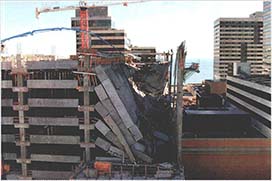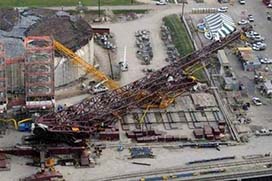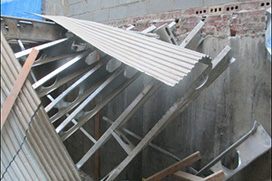Construction Incidents Investigation Engineering Reports
Construction Incidents Investigation Engineering Reports
March 1997: Investigation of the October 12, 1996 Collapse of a 1500-Feet High Antenna Tower in Cedar Hill, TX
A 1462 feet high antenna tower, collapsed while "jumping" a gin pole with a track near the top of the tower to replace an existing antenna. The workers fell to the ground with the falling sections of the tower. Three workers were killed.
A steel structure under construction 176 ft. x 312 ft. and 130 ft. high collapsed at the construction site for the Olympic Aquatic Center in Atlanta, Georgia. The structure, was an addition to the existing pool structure. Just prior to the collapse, the steel erection crew had erected a steel frame and a pair of steel joists spanning 176 ft. from an existing structure to the erected steel frame. The failure occurred within 15 to 30 minutes after the crane was released from the paired joists. The incident did not result in any injuries.
The building project under construction was a 31-story condominium complex. Five employees were applying stucco to the fascia walls when the platform of a mast climbing work platform (scaffold) collapsed. Three employees were on a modified cantilever deck section, which was connected to platform extensions attached to the main platform. The cantilever deck failed and as a result, the three employees fell about 75 feet where they were fatally injured. The other two employees working on the platform, were able to grab and hold on to the structure, and sustained only minor injuries.
A 350 ft. high guyed radio transmission tower collapsed during the final phase of its construction. Three FM antennas were already hoisted and fastened to the top sections of the tower. On the day of the incident, two workers positioned near the top section of the tower were beginning to lower the gin pole from the top section of the tower to the ground. The gin pole suddenly dropped and struck the coaxial cable, followed by the collapse of the tower. Both workers, who were tied to the collapsing tower, fell to the ground, resulted in the death of one worker and serious injuries to the other. The tower structure consisted of 25 pre-fabricated steel sections, each 10 ft. or 20 ft. in height.
December 1992: Investigation of July 20, 1992 Offshore Drilling Accident, Massachusetts Bay, Massachusetts
A pile top drill unit and a 206 feet long pipe casing, 68-inch diameter suddenly dropped 25 feet into the soft ocean sediment bed as the crane of the jack-up barge was releasing a 80 ton bottom hole assembly onto the platform of the drill unit. The fall of the drill unit caused injuries to three employees working on the platform. One of them was fatal. The steel casing was horizontally held above sea level by the jack-up barge, which was supported on four legs, each 7.5 feet square in cross-section.
A construction worker was killed and two workers were injured when their work platform, about 230 ft. above ground, was struck by a collapsing steel post, during the erection of the roof cable structure at the Georgia Dome in Atlanta, GA. The workers were in the process of hoisting the center truss in position to make the final connection of a diagonal cable to the bottom joint of the center truss. The construction workers were using hydraulic pumps to apply loads to the temporary jacking strands in order to make the permanent diagonal cable connection to the center truss.
May 1991: Investigation of November 19, 1990 Excavation Collapse at 14th and H Streets, N.W. Washington, D.C.
The structural steel support system of an open excavation, 150 ft. x 208 ft. by 47 ft. deep collapsed causing a cave-in of several thousand cubic yards of soil. The excavation was done for the construction of a 12-story office building with four levels of underground parking. The collapse caused the internal support system to slide and fall into the open excavation. At the time of the incident, construction had stopped for the day and therefore did not cause any death or injury, though it had significant potential for casualties.
The building under construction, the Airside Building, consisted of precast concrete beams, columns and precast prestressed hollow core concrete planks. During the erection and placement of hollow core precast planks at the roof level, several precast concrete beams, column, and hollow core planks at the roof and concourse levels collapsed. One construction worker, on the concourse level, died due to the falling debris of the collapsed beams and planks. Another construction worker was seriously injured.
A tower crane collapsed in the center of the financial district in San Francisco, California. Four construction workers engaged in the climbing operation of the crane and one person on the street below the crane were killed. The SN 355 model crane, a climbing, luffing boom tower crane had a maximum reach of 192 feet and a maximum lift capacity of 17,000 pounds with two wire ropes. The height of the crane on the day of collapse was 298 feet and consisted of 15 identical sections added at different stages. On the day of the incident, climbing process was underway to add another tower section.
Only selected reports are posted on this webpage. For assistance with any of the reports, figures or illustrations, please contact the Directorate of Construction at (202) 693-2020.
- OSHA finds that structural engineers must specify the order and manner of replacing existing diagonals and strut members of cellular towers. Onsite judgement by workers engaged in retrofit of towers has often proven to be disastrous. (October 2018)
- OSHA finds that the contractors and engineers should consider turbulent winds causing uplift and vortex in areas exposed to tropical storms and hurricane. OSHA recommends analysis based on Computational Fluid Dynamics (CFD) calculations. (September 2018)
- OSHA finds that the contractor not laying the boom and jib in the face of impending wind in accord with the crane manufacturer's instruction caused the collapse of the crane. (July 2016)
- OSHA finds that contractors must exhibit abundance of caution and supervision during dismantling of mast climbing platforms, not to overload the platforms causing failure of the mast. (August 2015)
- U.S. Department of Labor Announces Initiative to Increase Awareness Of Trenching and Excavation Hazards and Solutions, OSHA News Release (November 28, 2018)
- U.S. Department of Labor Cites Five Contractors for Safety Violations Following Florida Pedestrian Bridge Collapse, OSHA News Release (September 18, 2018)
- U.S. Department of Labor Cites Pennsylvania Crane Manufacturer for Exposing Employees to Safety Hazards after Fatal Crane Collapse, DOL News Release (August 6, 2018)
- U.S. Department of Labor Cites Communication Tower Contractor Following Three Fatalities at Miami Work Site, OSHA News Release (March 27, 2018)
- OSHA finds that overloading led to Providence, Rhode Island, circus fall Ringling Bros. and Barnum & Bailey Circus cited for serious safety violation. OSHA Regional News Release, (November 4, 2014).
- US Labor Department and Federal Communications Commission announce working group to prevent fatalities in telecommunications industry. OSHA News Release, (October 14, 2014).
- Structural Collapses During Construction - Lessons Learned, (1990-2008) (PDF). STRUCTURE magazine. OSHA investigated 96 structural collapses during construction involving fatalities and injuries from 1990 to 2008. Construction errors contributed to 80% of the structural collapses while the remaining 20% of the incidents are attributed to structural design flaws. (December 2010).













